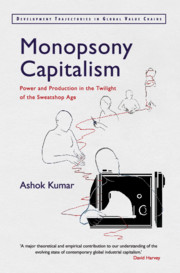This post has been contributed by Dr Ashok Kumar, Birkbeck. Dr Kumar’s book Monopsony Capitalism: Power and Production in the Twilight of the Sweatshop Age has been published by Cambridge University Press in 2020
I’ve been an organiser around the issues at work, workers, and internationalism since at least my first year of college. This was a key motivation for this book, which looks at the ‘sweatshop sectors’ (garments and footwear primarily) to try and understand how workers can make gains against seemingly impossible conditions. Indeed, building unionization and workers’ power in garment sweatshops has proven to be a Sisyphean task. Dispossessed and dispensable workers did organize, but this also brought great difficulties. For when they demanded recognition for their unions or took strike action, the factory owners would retaliate — often viciously. And even if the workers succeeded in besting their bosses in their own workplaces, the now-unionized factories would come under threat from buyers — ever liable to “cut and run” to the next factory, where labour was still unorganized and thus cheaper.
After analysing cases in India, China, Honduras and the United States, my book puts forward two primary claims. Firstly, that there is a universal logic that governs the supply chain, and that this is reflected back on to the labour process and workers’ bargaining power. These logics are based primarily on a single variable: the degree of monopsony power.
Here’s where the unequal power dynamic of many sellers and only a few buyers — a situation known as monopsony — becomes central. The garment and footwear sectors rely on this dynamic to guarantee power and profits for transnational buyers (the brands and retailers), even as the supplier firms — the outsourced factories themselves — get by on low margins. Supplier firms unable to reach these transnational buyers’ price demands risk losing orders — or having to close entirely.
This dependence leaves manufacturers in a state of perpetual instability — unable to muster the capital necessary to escape the orbit of brand power and pursue their own development. The possibility that they will lose a purchasing contract thus remains an inexorable and existential threat. This ensures chronically low profits, little investment in fixed capital (such as machinery), and almost no margins for workers to make demands from their direct employers. The result is a “race to the bottom” in which garment and footwear workers have the lowest bargaining power of any industrial sector.
But why is this true of garments rather than other sectors? Imagine you’re an Indonesian or Indian capitalist. You can establish an export-oriented garment factory with 3,000 workers with no more than £1 million, whereas an auto factory would be no less than £100 million, and an airplane factory would easily run you £1 billion. Garment and footwear thus have a low barrier to entry for emerging capitalists. This makes for a large number of factories. Naturally, this number keeps growing with trade liberalization, as more domestic capitalists join the global market.
A supply chain with a high degree of monopsony functions through bottlenecks. Here, tens of thousands of suppliers will fight for purchases from a small number of buyers — ensuring high profits for buyers and low profits for suppliers. A high degree of monopsony power thus flows from a low-investment, low-technology sector — allowing tens of thousands of factories to be created with a relatively small amount of capital.
The garment and footwear industries are one of the leading edges in the advance of globalization and the spread of outsourced supply chains — and they epitomize the tension between labour and capital under globalization. These industries are “starter” sectors — training wheels in the course of a country’s economic development. Starter sectors offer clues to the direction of capitalist development by paving the road — sometimes literally — for more advanced industries. Within these sectors, there are products that are ephemeral by nature, sensitive to seasonality and fashion, and those that are not, and are therefore subject to standardization and mechanization.
In the book, I examine a number of workers’ struggles in the most “valorizable” sections of these starter sectors (i.e., those most able to capture value or, in this context, most able to develop technologically). In so doing, we can understand what shapes and circumscribes industrial capitalism and workers’ structural power within it.
Contrary to what neoclassical economists might have you believe, workers at the level of the firm do not get what they deserve — they get what they demand, from within what is available. Indeed, the primary explanation for the persistence of the sweatshop, and its reemergence under globalization, is workers’ effective inability to make demands at the point of production.
In my book, I trace the history of these labour-intensive manufacturing sectors to show that, time and again, attempts by workers to organize have been crushed in much the same manner, by a hypermobile capital. This has followed from New York to “right-to-work” states in the Southern United States, to the maquilas, then to Central America, and finally to the labour-rich countries of Asia. In each case, I show that the bargaining power of workers is contingent on the degree of monopsony power. When this power is high and buyers (brands, retailers) can choose to shop around, workers can demand less; when it is low, workers demand more.
In order to illustrate sweatshop workers’ position, the book begins on April 23, 2013, with the collapse of the Rana Plaza — a commercial building in Dhaka, Bangladesh, that was home to numerous garment factories. Of the 3,100 (mostly women) workers employed at the site that day, 1,129 died, and many more were injured. This was the deadliest structural failure in modern human history.
This was not an isolated case. The previous November, a fire raged through Dhaka’s Tazreen Fashion Factory, killing 112 and injuring 200. Tazreen had been producing clothes for Walmart, Sears, and Disney. Indeed, the last four months of 2012 were particularly deadly. The Tazreen disaster, together with three other factory fires in three other countries, took a total of almost 500 lives — concluding what was then the deadliest year in history for sweatshop workers. Just four months later, Rana Plaza broke all records.
The Rana tragedy is often compared to the 1911 Triangle Shirtwaist Factory fire, which killed 146 in New York City. Indeed, the same dynamics that created the Triangle Shirtwaist disaster — now a solemn milestone discussed in American history textbooks — still hold sway, but on a global scale.
Like Rana, the Triangle Shirtwaist Factory was located in the top floor of a complex well known for its dangers. The factory was run by strongmen in a city rife with corruption, employing almost exclusively young women. In the decades leading up to the Triangle Shirtwaist disaster, New York City’s garment district had become a locus for domestic apparel production. As tales of shop-floor crowding and long hours in the district’s Lower East Side factories gradually made their way into the press, the term “sweatshop” entered the public imagination.
Just like today, brand companies at the turn of the twentieth century maximized profits by creating bidding wars between factory owners. In order to stay competitive and thus survive, the owners would increase downward pressure on workers. Workers at the factory-floor end of this chain were left with poverty wages, deteriorating workplace standards, and rising incidences of factory fires and building collapses.
My motivation for writing this book was this landscape of unending tragedies. But more than that, I wanted to answer the question of why labour organizing always comes up against a brick wall. It turned out to be a book about much more — for these sectors have so much to say about work under global capitalism.

